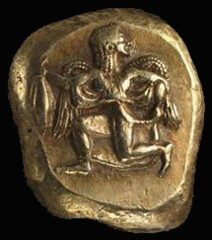
About UsThe Numismatic Bibliomania Society is a non-profit organization promoting numismatic literature. For more information please see our web site at coinbooks.org SubscriptionsThose wishing to become new E-Sylum subscribers (or wishing to Unsubscribe) can go to the following web page link MembershipThere is a membership application available on the web site Membership Application To join, print the application and return it with your check to the address printed on the application. Membership is only $15 to addresses in the U.S., $20 for First Class mail, and $25 elsewhere. For those without web access, write to: David M. Sundman, Secretary/TreasurerNumismatic Bibliomania
Society AsylumFor Asylum mailing address changes and other membership questions, contact David at this email address: dsundman@LittletonCoin.com SubmissionsTo submit items for publication in The E-Sylum, just Reply to this message, or write to the Editor at this address: whomren@coinlibrary.com
BUY THE BOOK BEFORE THE COINYou won't regret it! |
- WAYNE'S WORDS: THE E-SYLUM JULY 8, 2012
- MORE ABOUT THE PAPER CURRENCY OF TIBET BOOK
- MONETA OFFERS PUBLICATIONS ON 19TH CENTURY MONETARY HISTORY
- THE JUNE 2012 ISSUE OF MONETA HAS BEEN PUBLISHED
- QUIZ ANSWER: MONTROVILLE W. DICKESON
- NOTES FROM E-SYLUM READERS: JULY 8, 2012
- MORE ON THE 1976 PHILADELPHIA MINT EXHIBIT
- CIVIL WAR MEDAL OF HONOR (TYPE II) OFFERED FOR SALE
- MEDAL CABINET LINING MATERIAL
- SOBS TO GET TOGETHER IN CALGARY
- MEDAL OF THE MONTH CLUB: BURANELLI AND BURNELLI
- HUNTERIAN MEDAL EXHIBIT TO FOLLOW FIDEM XXXII ART MEDAL CONGRESS
- EXHIBIT: WHITE GOLD: REVEALING THE WORLD'S EARLIEST COINS
- URSULA KAMPMANN'S NUMISMATIC VISIT TO JERUSALEM
- ARTICLE HIGHLIGHTS URSULA KAMPMANN'S NUMISMATIC CAREER
- BOLING AWARDED HONORARY DOCTORATE OF NUMISMATICS
- ARTICLE PROFILES LOONIE DESIGNER ROBERT-RALPH CARMICHAEL
- MORE LOONIE LORE
- RARE AND IMPORTANT 16TH CENTURY MAP DISCOVERED
- THE FORGOTTEN LIBRARY
- ARGENTINE BANKNOTE ERROR CREATES A DOUBLE-ZERO DENOMINATION
- THE DIFFERENCE BETWEEN LEGAL TENDER AND SPENDING MONEY
- MAN PAYS OFF MORTGAGE IN CENTS
- FEATURED WEB PAGE: CLICK COINS
WAYNE'S WORDS: THE E-SYLUM JULY 8, 2012

New subscribers this week include Bob McCabe and Anthony Terranova. Welcome aboard! We have 1,567 email subscribers, plus 183 followers on Facebook.
This week we open with more information on Wolfgang Bertsch's new book on the Currency of Tibet, some new publications from Moneta, and a new edition of the (unrelated) moneta publication. Other topics include Montroville W. Dickeson, materials for lining medal cabinets, and three numismatic exhibits from around the world.
To learn more about restrikes of the Continental Dollar, the FIDEM XXXII Art Medal Congress, the Loonie coin designer, burglar-proofing coin collections and those SOBs in Calgary, Canada, read on. Have a great week, everyone!
Wayne Homren
Editor, The E-Sylum
MORE ABOUT THE PAPER CURRENCY OF TIBET BOOK
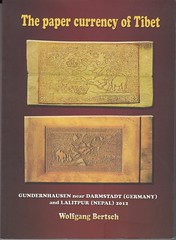 Wolfgang Bertsch: The Paper Currency of Tibet. Gundernhausen near Darmstadt (Germany) and Lalitpur (Nepal), 2012. VI plus 274 pages. ISBN 978-99933-982-7-1
Wolfgang Bertsch: The Paper Currency of Tibet. Gundernhausen near Darmstadt (Germany) and Lalitpur (Nepal), 2012. VI plus 274 pages. ISBN 978-99933-982-7-1
Tibetan banknotes were issued between 1912/13 and 1959. The first series of "Tam" notes was printed by hand with woodblocks on handmade paper. The multicoloured 50 Tam notes and the following issues in "Srang" were machine printed on native papers. All Tibetan notes were numbered by hand by specially trained calligraphists. Owing to their artistic design Tibetan banknotes can be considered as part of Tibet's cultural heritage.
This book explores the historical background which led to their issue, the way in which they were produced and the merit of their artistic design.
The first four chapters of the book are dedicated to the paper notes which were printed and released in Lhasa and include a catalogue part with estimated values of the different issues and their variants. The fifth chapter is dedicated to semi-official notes issued by an Eastern Tibetan monastery, while the last chapter is dealing with banknotes which bear both Chinese and Tibetan inscriptions and were put into circulation by Chinese authorities in the former province of Xikang which comprised parts of Eastern Tibet and Western Sichuan. Ten appendices provide further information for the specialist and an extensive bibliography concludes the book.
The book is profusely illustrated; all types of the banknotes and many variants and trial prints are reproduced in colour.
With this comprehensive study of Tibetan paper money the author has in mind both the more academically inclined reader who wants to be thoroughly informed about one fascinating aspect of Tibet's cultural history of the 20th century and the collector of Tibetan banknotes who wishes to identify the pieces in his collection and find out their approximate market value.
Wolfgang adds:
The book can be ordered from the site which you had given in your first notice on the book:
e-mail: shankar765@yahoo.com
or consulting the following website: www.nuphil.com/contact.html
To read the earlier E-Sylum article, see: MORE ON THE PAPER CURRENCY OF TIBET BOOK (www.coinbooks.org/esylum_v15n26a06.html)
MONETA OFFERS PUBLICATIONS ON 19TH CENTURY MONETARY HISTORY
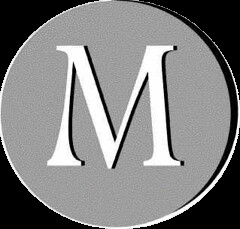 The Moneta web site (www.moneta.be) has been updated with new publications concerning the 19th c. monetary history, the Imperial Osaka Mint.
The Moneta web site (www.moneta.be) has been updated with new publications concerning the 19th c. monetary history, the Imperial Osaka Mint.
Since January 1st 2012, 18 volumes have been published concerning all aspects of numismatics and monetary history, from Antiquity to 19th c. (volumes # 131-148).
The previous volumes concern coins finds, hoards, monetary history, medals, technology, in Europe, Asia, etc. from Celtic and Greek Sasanian, Islamic, Japanese issues to the 20th c. or monetary history and monetary theories;
The DAMIN program website www.anr-damin.net has also been updated with new information concerning the future meetings: Madrid 2013; Osaka and Copenhagen 2014; Sicily 2015.
To visit the Moneta web site, see: www.moneta.be
THE JUNE 2012 ISSUE OF MONETA HAS BEEN PUBLISHED
Moneta Editor Serge Pelletier writes:
 The latest issue of moneta, the journal of the Ottawa Numismatic Society, is now available on-line at www.ons-sno.ca
The latest issue of moneta, the journal of the Ottawa Numismatic Society, is now available on-line at www.ons-sno.ca
Please note that the members of the Society voted unanimously in favour of making moneta available to all, FREE. So, you will find this, and past issues, on our website.
To read the June 2012 issue of moneta, see: www.ons-sno.ca/Moneta_CURRENT_PV.pdf
THE BOOK BAZARRE
QUIZ ANSWER: MONTROVILLE W. DICKESON
Last week I asked about Montroville W. Dickeson's connection to numismatics. Dave Hirt answered:
He was the writer of the American Numismatical Manual. I have the 1860 edition in my library. His collection of coins was sold in several Birch sales, also several sales cataloged by Ebenezer Mason.
The obsolete word "Numismatical" in the title is one clue to the unique nature of this book, one of the most important in U.S. numismatic history. Here's what Len Augsburger wrote about it in the Numismatic Bibliomania Society's compilation of The One Hundred Greatest Items Of United States Numismatic Literature. Pictured is the 1865 3rd edition from my library.
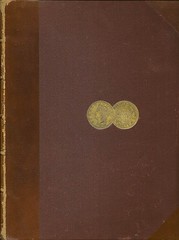 One often thinks of the Redbook as the "first" standard guide, but Dickeson is the true eye opener. Here is the "straw man," the first attempt at a comprehensive overview of American coinage. While the plates look like play money and technical errors abound (for example, the 1797 half dollar is unlisted), Dickeson represents a necessary stepping stone in American numismatic scholarship. An accumulative science by definition evolves, and Dickeson could have done much worse as he drew upon the few written sources along with personal contacts in the nascent numismatic community. The result was the first comprehensive, illustrated view of aboriginal, colonial, federal, pattern, and territorial coinage. While modern guides are far more accurate (and affordable), they do not convey the wonder of birth that one senses in Dickeson.
One often thinks of the Redbook as the "first" standard guide, but Dickeson is the true eye opener. Here is the "straw man," the first attempt at a comprehensive overview of American coinage. While the plates look like play money and technical errors abound (for example, the 1797 half dollar is unlisted), Dickeson represents a necessary stepping stone in American numismatic scholarship. An accumulative science by definition evolves, and Dickeson could have done much worse as he drew upon the few written sources along with personal contacts in the nascent numismatic community. The result was the first comprehensive, illustrated view of aboriginal, colonial, federal, pattern, and territorial coinage. While modern guides are far more accurate (and affordable), they do not convey the wonder of birth that one senses in Dickeson.
To read the complete entry on Dickeson's American Numismatical Manual, see: wiki.coinbooks.org/index.php/THE_AMERICAN_NUMISMATICAL_MANUAL
Dickeson's best known link to the Centennial was his Continental Dollar replica that he commissioned and sold as souvenirs at the Centennial Exhibition in Philadelphia. Less well known is his second contribution to the Exhibition. Based on the pioneering archaeological work that he had done from 1837 to 1844 studying the Indian burial mounds of the Mississippi River Valley, Dickeson commissioned a huge panorama of that expedition which was executed by John J. Egan, an itinerant Irish artist. Egan used the drawings and renderings of Dickeson as his source material.
Panoramas were a popular attraction in the mid-nineteenth century. They were a precursor to the moving picture in which the painted canvas was unrolled a bit at a time to give the impression of traveling along the landscape. Dickeson's panorama was about eight feet high by 350 feet long and consisted of 27 scenes. It was unveiled at Memorial Hall (also known as the Art Gallery) at the Centennial Exhibition in 1876. It remained on display there until 1885. The Dickeson panorama is the only one that survives from that period, and it is now displayed at the City Art Museum in St. Louis, Missouri.
Now, back to Centennial numismatics. Less is actually known for certain about Dickeson's Continental Dollar (diesinker, quantities, etc.) than his panorama, but the dies that he commissioned have a fascinating history. In February 2006, Jeff Shevlin, in the first issue of the So-Called Dollar Collectors' Club Journal, published a very thorough article on Dickeson's and subsequent restrikes of the Continental Dollar. I am indebted to him for much of the information here.
After the Centennial, Dickeson's dies disappeared from view until about 1917 when Thomas Elder acquired them and used the obverse die to strike four of his medals. Then they disappear again until 1962 when Q. David Bowers, then of the Empire Coin Company, used both dies for 7,200 pieces in pewter (sometimes cataloged as white metal or tin). Then, later that same year, Robert Bashlow used the dies to strike copies in silver (2,000 pieces), goldine (3,000), and bronze (5,000). There are rumors of examples in aluminum and other off-metals, but I have not (yet) seen them myself.
Here's where the story gets interesting. Bashlow announced publicly that after his use of the dies he would donate them to the Smithsonian, thus preventing any further copies ever being made. However, not as publicly, he first had working hubs made from the dies, which could be used to make additional dies. From these, he made at least two new sets of dies. For his silver copies he modified one of the reverse dies with the letter "S" at about 6:30 between the Delaware and Pennsylvania rings. One or both of the obverse dies and the "S" dies were then used to strike the silver copies. The other reverse die was used for the goldine and bronze versions.
In 1964, yet another version of the dies was made with "6TH Boy Scout Jamboree '64"cut into the "FUGIO" ring of the obverse and the word "COPY" added directly above the Delaware ring on the reverse. I do not know if these were two new dies from the transfer hubs, or if the plain (no "S") reverse and/or one of the obverse dies from the goldine and bronze restrikes were used.
To read the earlier E-Sylum article, see: MONTROVILLE W. DICKESON'S PANORAMA ON DISPLAY IN ST. LOUIS (www.coinbooks.org/esylum_v15n28a31.html)
NOTES FROM E-SYLUM READERS: JULY 8, 2012
Dave Hirt on the Shorthouse Collection
On July 4th Dave Hirt wrote (from Budapest):
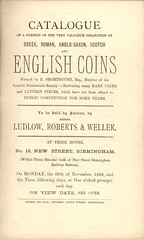 I really enjoyed this week's post. Many things of interest to me.
I noticed that in the recent Kolbe-Fanning sale, a copy of Chapman's sale of the Shorthouse
collection sold for $275 on a $75 estimate. It looks like the E-Sylum discussion of Shorthouse and his coins must have created some interest in that sale.
I really enjoyed this week's post. Many things of interest to me.
I noticed that in the recent Kolbe-Fanning sale, a copy of Chapman's sale of the Shorthouse
collection sold for $275 on a $75 estimate. It looks like the E-Sylum discussion of Shorthouse and his coins must have created some interest in that sale.
I also enjoyed the WSJ article and photos on home libraries. Perhaps some of our readers would submit photos of their libraries. I am far away, but thinking of all my numismatic friends on the 4th.
To read the earlier E-Sylum articles, see:
AMERICAN COINS IN THE SHORTHOUSE COLLECTION
(www.coinbooks.org/esylum_v14n23a12.html)
MORE ON AMERICAN COINS IN THE SHORTHOUSE COLLECTION
(www.coinbooks.org/esylum_v14n24a23.html)
MORE ON AMERICAN COINS IN THE SHORTHOUSE COLLECTION
(www.coinbooks.org/esylum_v14n25a12.html)
Burglar-Proofing Coin Collections
Bill Rosenblum writes:
Another excellent issue as usual. The stories by Harvey Stack about where collectors keep their collections reminded me of a couple that would stop by my office in Denver in the mid-1970's every month or so to buy a gold coin. The wife wrote a column on Pets for one of the two Denver daily papers at the time either the Denver Post or the Rocky Mountain News. I can't remember what the husband did for a living but he was most likely retired or at least semi-retired as the couple was probably in their 70's at the time.
After one purchase we got to talking as people are apt to do and as they left one of them said, well let's go put the coin away. I asked if they kept their collection in a bank vault or if they had a safe at home with an alarm system. They said they had a better system, - they had a very large and protective German Shepherd and they kept their coins in the bottom of the kibble bag. Nobody would get past him they said.
I'm not sure what ever happened to their coins after they died but I do remember when we moved our home and office six years ago and the guy who installed our security system told me that "he shouldn't be telling me this but the biggest deterrent against burglars and home invasions were large and mean sounding dogs." At least according to a survey of people who had got caught and were serving time in California prisons!
To read the earlier E-Sylum article, see: HIDDEN COINS: HERBERT DIETZ AND MARTIN KORTJOHN (www.coinbooks.org/esylum_v15n28a15.html)
Phooey on Contemporary Slang
Stephen Searle writes:
The term "Obamacare" is a slur and has no place in The E-Sylum. Phooey on Mr. Johnson for using the term and on you for repeating it unedited.
To read the earlier E-Sylum article, see: DICK JOHNSON ON STOLEN VALOR: MEDAL CHEATS TRIUMPH (www.coinbooks.org/esylum_v15n28a16.html)
"In Good Nick" - Origin Not Coin-Related
Kerry Rodgers of New Zealand writes:
Some of those Jersey coins look in quite good nick. And the term has nothing to do with coins being clipped or mutilated in any way. I find too too many definitions given on-line are garbage.
To read the earlier E-Sylum article, see: VOCABULARY PHRASE: IN GOOD NICK (www.coinbooks.org/esylum_v15n28a13.html)
Omissions from the 2013 SCWC 1901-2000
George Cuhaj of Krause Publications writes:
As to the 40th edition of the Standard Catalog of World Coins 1901-2000, yes, we certainly did leave out some listings. However, as a fix we have several alternatives. PDFs can be downloaded from the Numismaster site, a DVD of the missing sections will be tipped into the books not yet distributed, and the separate DVD product will have the full book, including the missing sections. The problem affected about 60 pages of listings, in various sections.
To read the earlier E-Sylum article, see: NOTES FROM E-SYLUM READERS: JULY 1, 2012: Omissions from the 2013 SCWC 1901-2000 (www.coinbooks.org/esylum_v15n28a12.html)
MORE ON THE 1976 PHILADELPHIA MINT EXHIBIT
Michael Schmidt writes:
We opened a new Philadelphia mint in 1976?? News to me. They may have done a remodeling in '76 but the current mint building is the same one they've used since 1969.
I had a chance to see that exhibit at the mint in August of 1976. I remember the special frames, but I don't remember any circular display racks. What I remember seeing was one long rectangular display rack with the frames in it.
To read the earlier E-Sylum articles, see:
HARVEY STACK ON THE PHILADELPHIA MINT ELIASBERG COLLECTION EXHIBIT
(www.coinbooks.org/esylum_v15n28a23.html)
REVAMPED PHILADELPHIA MINT EXHIBIT AND TOUR OPENS
(www.coinbooks.org/esylum_v15n28a24.html)
CIVIL WAR MEDAL OF HONOR (TYPE II) OFFERED FOR SALE
There was a lot more to it, and I didn't feel any more enlightened after reading it. But between the above snippet, Dick Johnson's statement and the other article quoted last week, I conclude that these trades are still indeed illegal. -Editor
Andy Singer writes:
Right after reading last week's newsletter I opened an email from Noble Numismatics. A Medal of Honor was third from the bottom of the list of highlights of their Sale 100 catalogue.
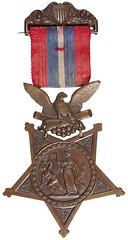

Lot 2417 USA, MEDAL OF HONOR (TYPE II) (1896-1904), reverse engraved, 'The Congress/to/1st Lt. Samuel B. Horne./Co.F.11th.Conn.Inf./for GALLANTRY at/Fort Harrison, Va./Sept.29./1864.' In original embossed case by Wm. Wilson & Son, Philadelphia, case hinge missing, with original breast and neck ribbon, both ribbons worn, medal extremely fine. Estimate$14,000
Medal for an action in 1864 but not awarded until 19 November 1897.
Samuel Horne, writing under the letterhead of 'Peck & Horne, Counselors at Law and Solicitors in Chancery of Grand Rapids, Michigan' on April 5th 1870 commenced a claim for compensation in respect of his Civil War service as he had not been correctly recorded as Captain nor paid in recognition of his promotion to the rank of Captain. His rank was officially corrected under Special Order No.282, Headquarters of the Army December 9, 1885. The financial reimbursement for such rank was rectified in the 54th Congress by a Bill H.R.7696 in House of Representatives on March 27, 1896 and S.2720 in the Senate on April 2, 1896.
In Deeds of Valor, p433 it states, 'With two dangerous wounds in his body Lieutenant Samuel B. Horne, of Company H, Eleventh Connecticut Infantry, was carried off the field at Cold Harbor, Va., June 3, 1864, and sent to a hospital. Though his recovery proceeded slowly, he could not bear to be confined to his bed and three months later returned to his regiment, though still an invalid. Ten days later, at Chapin's Farm, Va., September 29, 1864, he won his medal by a display of courage almost superhuman.'
This 'superhuman display of courage' was probably one of the factors why after investigating the claim, Horne received a letter from the Secretary of War dated November 4, 1897 which stated, 'You are hereby notified that by direction of the President and under provisions of the Act of Congress approved March 3, 1863, providing for the presentation of medals of honor to such officers, non-commissioned officers and privates as have most distinguished themselves in action, a Congressional Medal of Honor has this day been presented to you for Most Distinguished Gallantry in Action, the following being a statement of the particular service, viz:
'At Fort Harrison, Va., September 29th, 1864, this officer, then serving as First Lieutenant 11th Connecticut Volunteers, and acting as aide-de-camp to General Ord, while carrying an important message on the field was wounded and his horse killed; but not withstanding his severe wounds and sufferings, he continued on his way, delivered the order, and then joined his General but had to be taken to the rear on account of injuries received.' The medal will be forwarded by registered mail, as soon as it shall have been engraved.' In fact it was sent on November 19 and received by Horne on November 23, 1897.
On January 31, 1908 the War Department advised Horne that he was to be issued with another Medal of Honor of the new design to be engraved, 'The Congress/to/Captain/Samuel B.Horne,/Co.H,11th Conn.Inf.Vols./Fort Harrison, Va.,/Sept.29,1864.' The new medal was sent to him on February 21, 1908 and received on March 2, 1908.
To view the original lot description, see: www.noble.com.au/auctions/lot/?id=292723
To read the earlier E-Sylum article, see: QUERY: IS IT STILL ILLEGAL TO BUY AND SELL MEDALS OF HONOR? (www.coinbooks.org/esylum_v15n28a17.html)
MEDAL CABINET LINING MATERIAL
Dick Hanscom asked in last week's E-Sylum what to line the drawers in a cabinet to store medals. The answer is determined by what the medals are contained in now.
Answer One: If the medals are in slabs (horrors!) you don't need to line the trays with anything, NOTHING. Let the slabs lie loose. If they slide around as you pull out and return the tray drawer there is no problem. The medals remain protected. This holds true whether the cabinet is wood or metal. No problem. The back of the slabs may become marred but the medals remain unscarred.
Answer Two: If the medals are lacquered (as all fine art medals are). you only need to cushion them (to prevent them from sliding back and forth from opening and closing the drawer). This creates cabinet wear (that's the proper term for wear on the high points on the reverse, assuming of course you always place the medal obverse up). The best, time-honored material here is COTTON BATTING. This has been used for a century. This is also the filler material in Riker Mount trays. And for more than a century Medallic Art Co shipped all its medals in small boxes with the medal between two thin layers of cotton.
When the price of cotton rose, it was replaced by an artificial man-made material. It looks similar to cotton but is a bit more fibrous and "wirery." I have not heard yet if this is detrimental to any metal surface, the jury has yet to render a verdict.
Some collectors have chosen a cloth instead of pure cotton. What you want is a cloth that has been made -- both the material and the dyes -- sulfur free. Sulfur is the major cause of tarnish on the metal surfaces in which coins and medals are made, particularly copper and bronze. Jewelry supply houses offer a sulfur-free green cloth widely used in the jewelry industry.
Old-time numismatists wrapped their coins in anti-tarnish tissue (even folding up a small piece to fit in 2x2 envelopes). Anti-tarnish paper is still available and is still used to wrap silver objects purchased at better stores today (but it is too thin for drawer lining.
Answer Three: If all your medals are coin finish -- that is no finish and no lacquer as are all coins -- you will need TWO LAYERS, some tarnish protection in addition to cushion protection.
My partner, Mark Schlepphorst, turned me on to Intercept Shield (that's a trademarked name).. I was skeptical at first, but now I am an ardent fan of this material. It is about an 1/8-inch black material (maybe it comes in other colors) that prohibits tarnish. You could line your cabinet drawers with a sheet of Intercept Shield with a thin layer of cotton over it. This would give you all the protection you need. You could even lay raw BU or proof coins on the cotton with Intercept Shield beneath it in your cabinet drawers. No slip, no slide, no tarnish.
Intercept Shield comes in 40-inch wide sheets or strips but is not easy to obtain. The manufacturer prefers to sell to other manufactures to use in their products. Somehow my partner obtained several sample sheets and gave me a small portion to test. I love it. For more info: www.interceptshield.com/technology.html
Wizard Coin Supply may sell Intercept Shield sheets. I know they sell Intercept Shield boxes. If you need a small quantity contact my partner Mark Schlepphorst at mschlepphorst@charter.net
Dick, I congratulate your for desiring to recycle that cabinet. As a seasoned numismatist, there is no greater thrill to me than to have a collector show me his collection -- in a cabinet! Open a drawer and gaze on well described specimens arranged in an organized way. That's pure numismatic pleasure!
To read the earlier E-Sylum article, see: NOTES FROM E-SYLUM READERS: JULY 1, 2012: Query: Cabinet Lining Material (www.coinbooks.org/esylum_v15n28a12.html)

SOBS TO GET TOGETHER IN CALGARY

Speaking of the convention, there will be a "resuscitation meeting" of the Society of Bearded Numismatists. Founded by Jack Veffer a few decades ago, the Society kinda disappeared with him. RCNA Vice-President Bret Evans and other well known bearded numismatist (commonly called SOBs), are planning to revive the group. All are invited - except the folliclely challenged!
To read an earlier E-Sylum article, see: MORE ON THE SOCIETY OF BEARDED NUMISMATISTS (www.coinbooks.org/esylum_v12n05a16.html)
MEDAL OF THE MONTH CLUB: BURANELLI AND BURNELLI
The submission from David Alexander on the MOTMC is great stuff. I am hugely appreciative of his input. I knew about the talk to the NYNC in August 1941 but to get the minutes of the meeting is outstanding.
And following up on Mr. Alexander's confusion on the spelling of 'Buranelli,' one of the big breakthroughs I got when I was researching The Medal-Of-The-Month Club was that the spelling of both names was correct. The family name is Buranelli but sometime in the 20s Felicity Buranelli's brother Vincent dropped the 'a' in his name and became Vincent Burnelli. Once I figured this out research blossomed. Felicity had another brother by the name of Prosper Buranelli and my guess is Vincent changed the spelling of his last name to create a little space between himself and his older brother.
Prosper Buranelli (1891-1960) was a newspaper man on the Sunday World in 1919 when he was given the crossword puzzle placement assignment. In 1924 he co-edited with Margaret Farrar and Gregory Hartswick the first book of Crossword Puzzles and continued to do so for the next 49 editions. He is credited with popularizing the crossword puzzle. Prosper Buranelli was associated with Lowell Thomas for 34 years and the night before Buranelli died, he spent the evening in serious discussions with Lowell Thomas, Thomas E. Dewey, Edward R. Morrow and Dr. Norman Vincent Peale. Not a bad room to play before the final curtain. I read his obituary in the June 20, 1960 New York Times. He is an extremely interesting man!
To read the earlier E-Sylum article, see: MORE ON THE MEDAL OF THE MONTH (www.coinbooks.org/esylum_v15n28a14.html)
HUNTERIAN MEDAL EXHIBIT TO FOLLOW FIDEM XXXII ART MEDAL CONGRESS
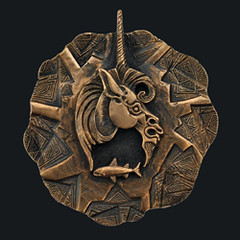
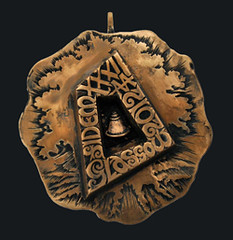
The official medal for FIDEM XXXII Glasgow 2012
Modern Medals
15 July - 19 August 2012
Hunterian Museum
Admission free
Featuring almost 1000 modern art medals from all over the world, this exhibition showcases the amazing diversity of this type of miniature sculpture, now recognised as an art form in its own right.
Medals are generally considered to be tokens of commemoration or reward, given for acts of bravery or sporting prowess. Dating as far back as the Renaissance, they are often thought of as small, round and flat, and produced to celebrate individuals or events.
Today artists' originality and creativity results in self-contained works of art in the manner of sculptures and paintings. The medals on display are a showcase for the artists' ability - a kind of 'Paris Fashion Week' for the medal world.
Many of the items included are larger than the more traditional medal and are made of metal, bronze, copper or an alloy. They appear in all shapes, forms and subjects, following the liberty of the artist to create his or her own work.
Arranged geographically by country of origin, there are examples from established schools of art medallists in Scandinavia and Eastern Europe. Britain, France and Germany are also represented as well as the United States, Australia, New Zealand and Japan.
The exhibition follows the FIDEM XXXII Art Medal Congress which takes place at the University of Glasgow from 10 - 14 July.
'Modern Medals' also coincides with an exclusive loan of London 2012 Olympic and Paralympic gold medals to The Hunterian from The London Organising Committee of the Olympic and Paralympic Games.
The two medals are on show at The Hunterian Museum from 10 until 22 July. The Hunterian is the only venue in Scotland to display the medals before the Games begin.
The Olympic and Paralympic gold medals complement the 'Modern Medals' show perfectly and offer a rare treat for both medal enthusiasts and sport fans. Visit the Olympic Gold page for further information.
To read the complete article, see:
Modern Medals
(www.gla.ac.uk/hunterian/visit/exhibitions/comingsoon/
modernmedals/#d.en.233548)
For more information on FIDEM, see: www.fidem-medals.org
EXHIBIT: WHITE GOLD: REVEALING THE WORLD'S EARLIEST COINS
François R. Velde writes:
The Israel Museum in Jerusalem just opened an exhibit on electrum coinage, the world's first coins. It displays two stunning private collections in a small but exquisitely designed space. The exhibit runs until March 2013; for those who cannot attend, the website presents spectacular photographs.

Cyzicus. Ca. 500-460 BCE. Stater (15.98g). Phocaic standard. Winged Nike running left, looking back, holding tuna by tail before her.
Nike, the personification of Victory, was usually depicted in Greek art as a winged female. She represented victory in all of its forms, in athletic, equestrian, and musicopoetic competitions, as well as military victory on the battlefield. Nike was often associated with Zeus and Athena, because victory was an attribute of both of these deities and a gift they could confer on the mortals they favored.
To visit the online exhibit, see: White Gold: Revealing the World's Earliest Coins (www.imj.org.il/exhibitions/2012/WhiteGold/index.html)
URSULA KAMPMANN'S NUMISMATIC VISIT TO JERUSALEM
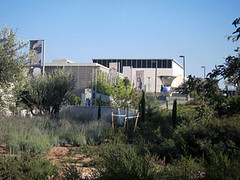 Numismatics concentrates on quite a narrow space in Jerusalem. There is the Israel Museum, which accommodates beside its own collection the Israel Antiquities Authority as well. And only a fifteen minutes' walk from there you will find the exhibition of the Bank of Israel.
Numismatics concentrates on quite a narrow space in Jerusalem. There is the Israel Museum, which accommodates beside its own collection the Israel Antiquities Authority as well. And only a fifteen minutes' walk from there you will find the exhibition of the Bank of Israel.
The Israel Museum is a building whose interior decoration impresses by attending to all wants a modern tourist might have. However, those who are going to the coin cabinet don't enter this building. Slightly staggered to the left there is an entrance guarded by a door-keeper which conducts to a labyrinth of narrow corridors lodging many various offices.
These rooms are small and cramped, full of computers technically not quite up to date. This, however, does not mean anything. I have seen many coin cabinets where supreme scientific results were achieved by using a minimum of equipment. And here it's the same. It is impossible to list all the numerous publications that spring from the numismatic department of the Israel Museum.
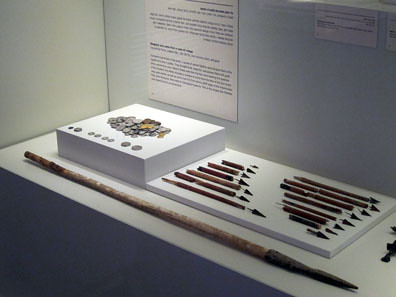
The coin exhibition's heart is a circular room dedicated exclusively to numismatics. There are on display only few, but gorgeous coins in order to raise the visitors' curiosity without boring the non-professional.
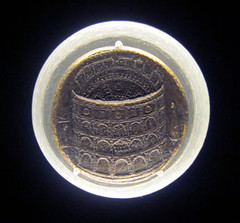 The coins are shown as precious treasures inserted at eye-level into the wall with a black background.
The coins are shown as precious treasures inserted at eye-level into the wall with a black background.
The Israel Museum was founded in 1965 and since then it has been Israel's national museum. Teddy Kollek, then Jerusalem's mayor, was the driving force behind this enormous collection. Kollek himself was an active coin collector, no wonder the numismatic department was at the centre of attention since the beginning. At this time Ya'akov Meshorer - many coin collectors might know him by his numerous books on Jewish numismatics - was appointed chief curator. In 1969 he established the numismatic department of the Israel Museum remaining his curator until 1993.
Then he was succeeded by Haim Gitler, who is still chief curator. He reigns over more than 25,000-30,000 coins among them one of the best collections of Jewish coins worldwide (comprising the Meir Rosenberg Collection and the Abraham Bromberg Collection) and what we call 'city coins', or issues of cities on the territory of modern Israel under Roman rule. In addition the Paul Balog Collection is situated in the Israel Museum, a comprehensive collection of Islamic coins with a large part of Mamluk issues.

To read the complete article, see: Numismatics in Jerusalem - Part 1 (www.coinsweekly.com/en/News/4?&id=1304)
THE BOOK BAZARRE
ARTICLE HIGHLIGHTS URSULA KAMPMANN'S NUMISMATIC CAREER
 On June 29, 2012 numismatist and CoinsWeekly publisher Ursula Kampmann has received the prestigious Otto-Paul-Wenger Award. At irregular intervals the Association of Swiss Professional Numismatists bestow that prize on those who are particularly engaged in propagating numismatics. As laudator Albert M. Beck, former editor of the German numismatic journal 'MünzenRevue', and founder and Honorary President of the WorldMoneyFair, stressed, the committee decided unanimously: 'We all agree that Ursula Kampmann is a worthy awardee.'
On June 29, 2012 numismatist and CoinsWeekly publisher Ursula Kampmann has received the prestigious Otto-Paul-Wenger Award. At irregular intervals the Association of Swiss Professional Numismatists bestow that prize on those who are particularly engaged in propagating numismatics. As laudator Albert M. Beck, former editor of the German numismatic journal 'MünzenRevue', and founder and Honorary President of the WorldMoneyFair, stressed, the committee decided unanimously: 'We all agree that Ursula Kampmann is a worthy awardee.'
Albert Beck enqueued Ursula Kampmann among the 'architects who know how to build an important bridge between classical numismatics and modern coin collectors.' He compared the awardee with a beekeeper distributing dripping honeycombs on many territories. Indeed not only coin collectors might know Ursula Kampmann but also many people dealing with coins in one way or another.
Because Ursula Kampmann, as the laudatio lists, has imparted her knowledge by articles since she had taken her doctoral degree in Ancient history and Greek numismatics in 1996. Especially as editor in chief of 'MünzenRevue' she has written more than 800 contributions for this journal but also for other specialized media. She has also established a certain reputation by her audio contributions and catalogue texts for museums, particularly on behalf of the MoneyMuseum Zurich.
But besides this she is active on areas often thought as incompatible with that kind of journalistic work: thus Ursula Kampmann acts at the interface between collectors and industry applying her competence to the world of the coin producing industry being editor of the 'MintWorld'; furthermore she was secretary of the International Bureau of the Suppression of Counterfeit Coins of the International Association of Professional Numismatists and spokeswoman of the International Association of Dealers in Ancient Art.
People often forget that Ursula Kampmann has much experience in the coin dealing business, too. She started her professional career writing catalogues for the Gieβener Münzhandlung. Then for nine years she has worked for Münzen und Medaillen AG in Basel.
In addition she still carries on with her academic interests as the many participations at congresses attest, lately in Jerusalem. But another current project, the annotated publication of the correspondence between the coin collectors Hans von Schellenberg and Johann Jakob Rüeger showing impressively how coin collecting came to life around 1600, testifies her unabated academic curiosity.
To read the complete article, see: Ursula Kampmann received Otto-Paul-Wenger Award (www.coinsweekly.com/en/News/4?&id=1306)
BOLING AWARDED HONORARY DOCTORATE OF NUMISMATICS
Longtime Summer Seminar instructor Joseph E. Boling was awarded the honorary degree of Doctor of Numismatics from the American Numismatic Association's Florence Schook School of Numismatics on Thursday in Colorado Springs, Colo. Boling is the eight recipient of this honor - a fact sure to please Boling, as he is an avid collector of items containing the number 8, including purchasing the eighth official medal set struck for the World's Fair of MoneySM every year.
Boling has taught at 14 consecutive Summer Seminars.
"Only Joe knows, without looking it up, exactly how many students he has taught in his Military Payment Certificate, Exhibit Judging and Detection of Counterfeit World Paper Money classes. He is, after all, a numbers guy - and, we might add, a very dedicated and effective instructor," said ANA Executive Director Jeff Shevlin.
The ANA's current Chief Judge, Boling is also a former member of the ANA Board of Governors, the 2005 recipient of the Farran Zerbe Memorial Award for Distinguished Service and an ANA member for 37 years. He is a former president of the International Bank Note Society and former secretary of the Pacific Northwest Numismatic Association.
Boling is a retired Army colonel, with a dual concentration MBA. Upon receiving the award, Boling said, "I am terribly honored to receive this. I called (Summer Seminar Project Manager Susan McMillan) to recommend someone for the award who wasn't here this week. But I'm happy to be his replacement."
Howard A. Daniel III adds:
I just learned my good friend, Joseph E. Boling, was awarded an Honorary Doctorate in Numismatics from the ANA! I have a question. When I introduce him to an audience, do I call him Doctor Colonel or Colonel Doctor?
ARTICLE PROFILES LOONIE DESIGNER ROBERT-RALPH CARMICHAEL
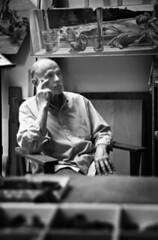 Robert-Ralph Carmichael's loonie still has wings.
Robert-Ralph Carmichael's loonie still has wings.
His artwork of a loon on Canada's one-dollar coin has been minted 1.5 billion times since it first took flight on June 30, 1987, just in time for the 120th anniversary of Confederation. In 2011, 25 million loonies were minted.
"It's lovely that there's so many images out there," said Carmichael, 74, in an interview earlier this week.
"I do enjoy seeing it on the television when they put up a big loonie when they're talking finance. It's kind of fun to see it."
Royal Canadian Mint hails the loonie's launch as the most significant development in Canadian coinage since designs now used, including the maple leaf on the penny and woodland caribou on the quarter, were introduced in 1937.
Carmichael's design was chosen after the master dies for the original selection of a voyageur went missing while in transit from Ottawa to Winnipeg.
"The loonie design has stood the test of time due to its simplicity in depicting an icon of Canadian wildlife," said Christine Aquino, the mint's director of communications in an e-mail.
"It is instantly recognizable."
In 2011, Royal Canadian Mint approached Carmichael to create a new loon design for a 25th anniversary fine silver one-dollar coin. Fifteen thousand were made.
"Two common loons swim majestically past one another, one admiring the loonie's eventful journey while the other looks to the future and the many adventures to come," reads a mint release.
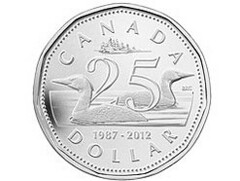 The number 25 appears in the coin's middle. Carmichael's wife, Gwen Keatley, assisted in the design.
The number 25 appears in the coin's middle. Carmichael's wife, Gwen Keatley, assisted in the design.
While Carmichael is not besieged by coin collectors, or numismatists, clamouring to be photographed with him, the artist does hear from Canadians curious about the landform in his original design's background.
"I have had a number of e-mails asking me if that island is the one that they know from their lake," he laughed.
"It's a generic island."
The loon was the first design by Carmichael to be accepted by Royal Canadian Mint after 10 years of effort.
"The loon dollar was the first, and I suppose the greatest," he said.
"You couldn't ask for a better introduction to having your work produced as a coin than that one. Everything followed that."
Carmichael's association with the mint has continued for more than 30 years.
His artwork is featured on about 15 different coins, including a $100 coin marking the 100th anniversary of the Library of Parliament (2001), a silver dollar commemorating the 250th anniversary of the Saint-Maurice Ironworks (1988) and a silver dollar celebrating the 400th anniversary of the first French settlement in North America (2004).
To read the complete article, see: Carmichael revisits loonie coin (www.saultstar.com/ArticleDisplay.aspx?e=3590882)
MORE LOONIE LORE
The introduction of the 11-sided loonie "was the most significant change to Canada's coinage in over 50 years," said Aquino, noting that the scrapping of the $1 bill vastly increased the lifespan of the average dollar and presaged the introduction of the polar bear "toonie" in 1996.
She said the switch to loonies was pushed by various interest groups across Canada, including transit companies eager to end the use of difficult-to-handle, small-denomination paper money.
"Organizations for the visually impaired, which we consulted with quite extensively back then, really appreciated the coin's 11-sided shape," she added.
The coin went on achieve mythic status at the 2002 Salt Lake City Olympics when a "lucky loonie" was secretly placed at centre ice by Canadian icemaker Trent Evans ahead of the gold-medal match - won by Canada over Winter Games host Team U.S.A., this country's first Olympic hockey title in 50 years.
Capitalizing on the story, the mint has struck special "lucky loonie" coins before each subsequent Olympic Games.
The loonie also made history in 2005 when Terry Fox - the heroic one-legged runner whose 1980 Marathon of Hope raised millions of dollars for cancer research - became the first Canadian-born individual depicted on a Canadian circulation coin. The 2005 loonie celebrated the 25th anniversary of Fox's epic, marathon-a-day fundraiser across Canada, which ended in Northern Ontario with a recurrence of his cancer. The illness claimed his life in 1981.
Earlier this year, after the minting of about 1.5 billion loonies since 1987, the coin was given its first major production makeover in a quarter-century.
The 2012 loonie is the first edition of the coin to be made of multi-ply, brass-plated steel - at 6.27 grams, a slightly lighter composition than the original nickel-core loonie.
The new coin, released in April, also features a laser-mark maple leaf above the bird's head for enhanced security.
To read the complete article, see: The loonie turns 25 years old (business.financialpost.com/2012/07/03/the-loonie-turns-25-years-old/)
RARE AND IMPORTANT 16TH CENTURY MAP DISCOVERED
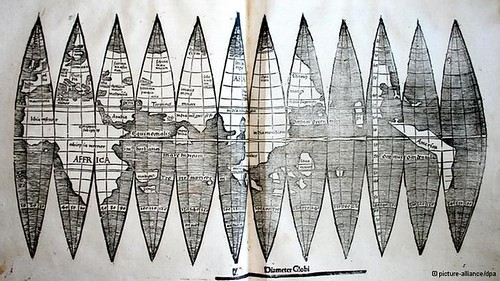
Munich librarians have found a rare 16th century world map that first gave America its name as a continent. The version by German cartographer Martin Waldseemüller survived World War II sandwiched between geometry books.
The Munich version is smaller than the 500-year-old global map found in a German monastery in 1901 and handed over by German Chancellor Angela Merkel in 2007 to the US Library of Congress. Only four smaller versions were previously known to have survived.
Waldseemüller (1470 - 1522) was the first cartographer to depict America as a separate continent on a global map and to name it after the Italian seafaring explorer Amerigo Vespucci. In his journals, Vespucci had described the eastern coast of what he saw as a new continent, which we now know is South America.
The Florentine navigator Vespucci was a younger contemporary of Christopher Columbus, the Italian in Spanish service who reached Central America in 1492 believing it was part of Asia while searching for a western trade route.
"We've made a sensational find," said Klaus-Rainer Brintzinger, the director of Munich's Ludwig-Maximilian University's library, referring to the latest Waldseemüller map to re-emerge.
The head of the university library's section for ancient books, Sven Kuttner said "there hasn't been a find of this dimension since World War II."
Several days ago, two women involved in catalogue correction at the library opened a bound 19th century folio containing two printed geometry works. Sandwiched between them was the smaller A4-sized Waldseemüller map, the university said in a statement. The folio had been bound together by Viennese librarians in 1871, and they apparently did not recognize the map's significance.
To read the complete article, see: 500-year-old global map found in Munich (www.dw.de/dw/article/0,,16069179,00.html)
THE FORGOTTEN LIBRARY
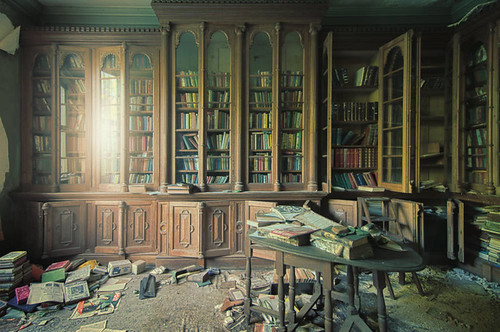
To read the complete article, see: Library in abandoned house (boingboing.net/2012/07/07/library-in-abandoned-house.html)
ARGENTINE BANKNOTE ERROR CREATES A DOUBLE-ZERO DENOMINATION
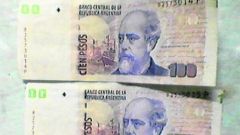 An issue of Argentine 100 Pesos bills printed in Brazil and in circulation in Buenos Aires was discovered to be missing the "1" which left them with only the double 00.
An issue of Argentine 100 Pesos bills printed in Brazil and in circulation in Buenos Aires was discovered to be missing the "1" which left them with only the double 00.
The discovery was reported by Clarin and picked up by the rest of the media and allegedly the Argentine currency printing house was aware of the error but even so as soon as the crates with the bills arrived from Brazil, allowed their circulation.
The 100 Pesos bill is the highest denomination of Argentine paper money and with inflation running at an annualized 'in the range of 25%' it is not surprising the urgency to have the bills in the streets.
The error in the bills emerged from the fact they were wrongly clipped on one side, cutting off the centennial and leaving the zeroes.
Argentine authorities admitted the mistake but said the number of bills in circulation was "irrelevant". Off the record they admitted the need for paper money since at mid year all dependent workers in Argentina are paid a mid year bonus equivalent to half a month's salary.
Workers at the Argentine currency printing house have been in conflict for several weeks interrupting production of bills and thus forcing the Central bank to have them printed in Brazil.
To read the complete article, see:
Roaring inflation: Argentine "double zero" peso bills are "legal tender"
(en.mercopress.com/2012/07/05/roaring-inflation-argentine-double
-zero-peso-bills-are-legal-tender)
THE DIFFERENCE BETWEEN LEGAL TENDER AND SPENDING MONEY
 What's the difference between legal tender and spending money?
What's the difference between legal tender and spending money?
A big headache for a Scarborough man who learned the hard way that banks aren't obligated to honour collector's coins at face value, even if they come from the Royal Canadian Mint.
Two months ago 32-year-old Orest Fokine took advantage of a deal on a new silver coin the mint had stamped to commemorate Queen Elizabeth's Diamond Jubilee.
The coin retails for $25, but Fokine was able to buy more than 30 of them at their $20 face value.
On Tuesday he needed money quickly, and with no cash at hand he headed to a CIBC branch near Kingston Rd. and Midland Rd. with one of his silver coins, hoping to exchange it for cash or deposit it into his account.
But the teller there told him he could do neither, rejecting Fokine's silver coin.
When he appealed to the manager he was again told he couldn't exchange the coin for cash.
When he tried a nearby Royal Bank and Bank of Montreal branches and heard the same answer, he got steamed. He had bought the coin legitimately and had been assured it was legal tender, so he couldn't figure out why the banks wouldn't recognize his coin as real money.
"This is the most ridiculous explanation I've ever heard in my life," Fokine says. "Nothing in the description of this coin states it's not currency."
So who is right, the customer with the legal tender coin or the banks who kept rejecting it?
They're both correct, says Royal Canadian Mint Alex Reeves.
He explains all coins produced by the mint are legal tender - meaning they can be exchanged for goods or services at face value - but only circulating legal tender can be readily spent and traded at business and banks.
Non-circulating legal tender refers to items like Fokine's silver coins and designated collectibles. Reeves says business can accept the money at face value if they choose, but they're also free to reject it.
"There's nothing forcing a bank or a business to accept (the coin)," Reeves says. "If someone offers me a gold Maple Leaf (coin) for $50 face value I'd be crazy not to take it, but it's still a coin that's not destined for circulation."
Reeves points out banks all have procedures by which customers can convert collectible coins to cash but acknowledges staff aren't always aware of them. In that case he suggests having the branch manager call the Mint so they can work through the conversion process.
Managers at the RBC branch Fokine visited have arranged to meet with him to discuss the coin.
To read the complete article, see:
Coin collector learns the difference between legal tender and spending money the hard way
(www.thestar.com/business/article/1221621--coin-collector-learns
-the-difference-between-legal-tender-and-spending-money-the-hard-way)
MAN PAYS OFF MORTGAGE IN CENTS
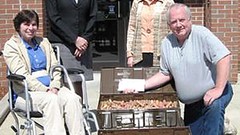 A Milford, Mass., man saved his pennies to pay off his mortgage--literally. He carted more than 62,000 pennies to the bank to make his last payment.
A Milford, Mass., man saved his pennies to pay off his mortgage--literally. He carted more than 62,000 pennies to the bank to make his last payment.
"Thirty-five years ago when my wife and I took out our mortgage for our first home I happened to pick up a penny in a parking lot," Thomas Daigle told ABC News. "I said, I'm going to pay our last mortgage in pennies.'"
And, that's exactly he did. In all, that's about 427 pounds of pennies at 145 pennies to the pound, though pennies minted after 1982 weigh in at 181 to the pound. Daigle says he didn't weigh them.
The 60-year-old, who would place his change and keys in a bowl each night, would sift through the change and save his pennies. On a rainy or snowy night in central Massachusetts, Daigle would roll three to five packs of pennies and place them in a box in the basement. Along with the pennies in a box downstairs, Daigle would keep a scrap of paper with a running tab of the amount of rolls stored in the boxes downstairs.
"After a few years of rolling pennies, I said this is a doable thing to pay my mortgage off in pennies," said Daigle.
In April, the co-owner of Joseph and Thomas Opticians brought the boxes of pennies around to the back at Milford Federal Savings and Loan Association and made his final payment on his 35th wedding anniversary.
To read the complete article,see: Mass. Man Pays Off Mortgage With Pennies (abcnews.go.com/Business/mass-man-pays-off-mortgage-pennies/story?id=16726959)
FEATURED WEB PAGE: CLICK COINS
This week's Featured Web Page is Click Coins, "The Start Page for Coin Collectors". While my computer was out of commission a reader asked about a site I'd mentioned that collects links to recent articles from multiple numismatic newsletters and blogs. I was unable to supply an answer at the time, but here it is: Click Coins. It's a convenient one-stop shop for articles from:
- Coin Update News
- Mint News Blog
- Coin Week
- United States Mint
- Numismatic News
- Coin World
- World Mint News Blog
- World Coin News
- Perth Mint Blog
- Perth Mint Bullion Blog
- Royal Mint Blog
- The E-Sylum (my favorite!)
- Proxiblog
- Coin Collectors Blog

http://clickcoins.com/

